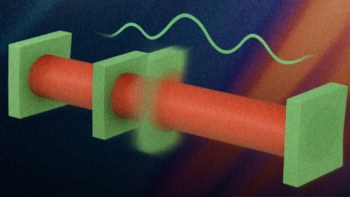
A new technique for measuring how antimatter falls under gravity has been proposed by researchers in the US. The team says that its device – based on cooling atoms of antimatter and making them interfere – could also help to test Einstein’s equivalence principle with antihydrogen – something that could have far-reaching consequences for cosmology. Finding even the smallest of differences between the behaviour of matter and antimatter could shine a light on why there is more matter than antimatter in the universe today, as well as help us to better understand the nature of the dark universe.
Up or down?
First detected at CERN in 1995, physicists have long wondered how antimatter is affected by gravity – does it fall up or down? Most theoretical and experimental work suggests that gravity probably acts in exactly the same way on antimatter as it does on matter. The problem is that antimatter is difficult to produce and study, meaning that no direct experimental measurements of its behaviour under gravity have been made to date.
One big step forward took place last year, when researchers at the ALPHA experiment at CERN measured how long it takes atoms of antihydrogen – made up of a positron surrounding an antiproton – to reach the edges of a magnetic trap after it is switched off. Although ALPHA did not find any evidence of the antihydrogen responding differently to gravity, the team was able to rule out the possibility that antimatter responds much more strongly to gravity than matter.
Waving matter
Such experiments are hard to carry out, however – antimatter is difficult to produce on a large scale and it annihilates when it comes into contact with regular matter, making it difficult to trap and hold. The new interferometry technique – proposed by Holger Müller and colleagues at the University of California, Berkeley, and Auburn University in Alabama – exploits the fact that a beam of antimatter atoms can, like light, be split, sent along two paths and made to interfere, with the amount of interference depending on the phase shift between the two beams. The researchers say the light-pulse atom interferometer, which they plan to install at the ALPHA experiment, could work not only with almost any type of atom or anti-atom, but also with electrons and protons.
In the proposed interferometer, the matter waves would be split and recombined using pulses of laser light. If an atom interacts with the laser beam, it will receive a “kick” from the momentum of a pair of photons, creating the split, explains Müller. By tuning the laser to the correct pulse energy, this process can be made to happen with a probability of 50%, sending the matter waves along either of the two arms of the interferometer. When the paths join again, the probability of detecting the anti-atom depends on the amplitude of the matter wave, which becomes a function of the phase shift.
Annihilation danger?
Müller adds that the phase shift depends on the acceleration due to gravity (g), the momentum of the photons (and so the magnitude of the kick) and the time interval between each laser pulse. Measuring the phase shift is therefore a way of measuring g, because the momentum and the time interval are both known. The biggest advantage of the technique is that the anti-atoms will not be in danger of annihilating because they will never come close to any mechanical objects, being moved with light and magnetic fields only.
Müller’s idea is to combine two proven technologies: light-pulse atom interferometry and ALPHA’s method of producing antihydrogen using its Penning trap. He points out that the team’s proposed method does not assume availability of a laser resonant with the Lyman-alpha transition in hydrogen, which can be very difficult to build. To make the whole experiment even more efficient, the team has also developed what Müller describes as an “atom recycling method”, which allows the researchers to work with “realistic” atom numbers. “The atom is enclosed inside magnetic fields that prevent it from going away. Thus, an atom that hasn’t been hit by the laser on our first attempt has a chance to get hit later. This way, we can use almost every single atom – a crucial feat at a production rate of one every 15 minutes,” he explains. This would let ALPHA measure the gravitational acceleration of antihydrogen to a precision of 1%.
Precise and accurate
The team plans to build a demo set-up at Berkeley, which will work with regular hydrogen, and hopes to secure funding for this soon. Müller and colleagues are now also part of the APLHA collaboration. “The work at CERN will proceed in several steps,” he says. “The first is an up/down measurement telling [us] whether the antimatter will go up or down,” he says. This will be followed by a measurement of per-cent-level accuracy. Müller’s long-term aim is get to a precision of 10–6, which would be vastly superior to ALPHA’s measurement last year, which has an error bar of 102. ALPHA can currently trap and hold atoms at the rate of four each hour, but thanks to recent upgrades at its source of antiprotons – the ELENA ring – CERN could theoretically produce nearly 3000 atoms per month. In addition to ALPHA, the GBAR and AEgIS collaborations are also planning to measure gravity’s effects on antimatter.
While Müller agrees that the gravitational behaviour of antimatter can be studied from experiments with normal matter, a direct observation is essential, and that is what Müller, the ALPHA collaboration and the other teams at CERN are keen to accomplish in the near future. “No matter how sound one’s theory, there is no substitute in science for a direct observation,” he says.
The research is published in Physical Review Letters.



